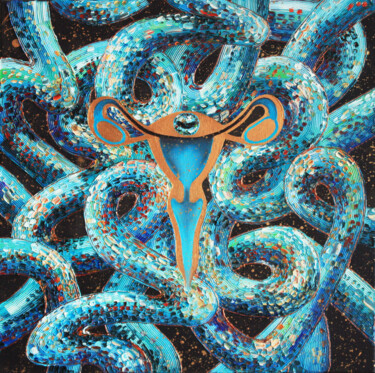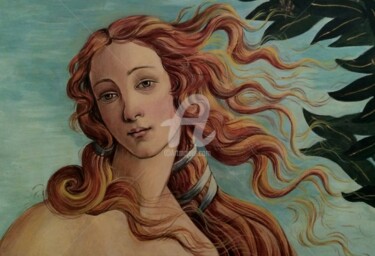Beauty
Beauty, an abstract concept long investigated over the centuries, is embodied in the experience of experiencing pleasant sensations, caused by objects, people, sounds or ideas, which are able to positively stimulate our senses, linking them to a positive emotional content. Moreover, we speak of beauty when an object, an idea or a person can make us happy, regardless of whether we own them or not. It is good to emphasize, however, as this concept of beauty is changeable and relative, since inextricably linked to a historical, cultural, economic and social context of belonging. What has been said can be exemplified by the evolution, over the centuries, of the depiction of the goddess of beauty, fertility and love, Venus. In order to show these figurative changes it is possible to refer to three Venuses that have indelibly marked the history of art: the Venus of Willendorf, the Venus of Milo, the Venus of Botticelli.
 Venus of Willendorf, 24,000-22,000 BC. Limestone painted in red ochre, 11 cm (height). Vienna: Naturhistorisches Museum.
Venus of Willendorf, 24,000-22,000 BC. Limestone painted in red ochre, 11 cm (height). Vienna: Naturhistorisches Museum.
The Venus of Willendorf
The Venus of Willendorf, the most famous of the Paleolithic Venuses, is an eleven-centimeter statuette depicting an upright, nude female figure with her arms resting over her breasts, her face unsculpted, and her head covered by a hairstyle or headdress. In addition, this female body, devoid of hands and feet, is characterized by very pronounced breasts, huge hips and disproportionate genitals. In reality, however, such physical characteristics could not belong to an era in which the availability of food was scarce, such as the Paleolithic, so that it seems more likely that the Venus, with its roundness, was a personification of fertility, a wish for survival and abundance, linked to the cult of mother earth. Finally, with regard to the material of realization of the work, the statuette, which is made of oolitic limestone of yellowish color, covered by a reddish clay material, has a porous appearance, which allows light to partially reflect on the surface, creating those chiaroscuros that determine the formal irregularities.
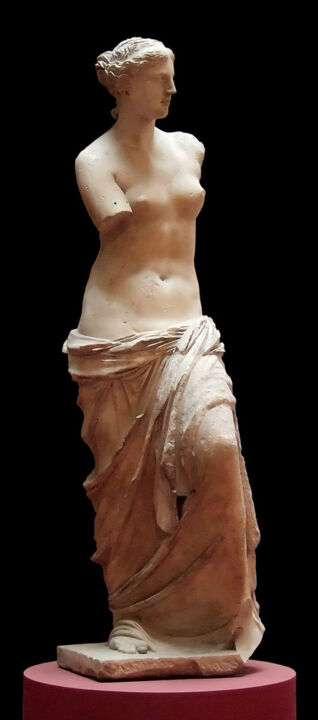 Alexander of Antioch, Venus de Milo, 130 B.C. Parian marble, 202 cm (height). Paris: Louvre Museum.
Alexander of Antioch, Venus de Milo, 130 B.C. Parian marble, 202 cm (height). Paris: Louvre Museum.
Venus of Milo
The Aphrodite of Milo, or Venus de Milo, dated 130 B.C. and preserved at the Louvre Museum, is one of the most famous sculptures in the world, which perfectly embodies the Hellenistic ideal of female beauty. This work, which refers to an episode in the life of Venus that is still unknown, depicts the goddess in an erect position, with her bust uncovered and a cloth that entirely covers her pelvis and legs. Therefore, the sculpture presents stylistic characteristics that can be traced back to two different periods: the upper part of the body, which is naked, recalls the statues of the divinities of the classical period, while the lower part, which is covered by a thick drapery, is purely Hellenistic. Moreover, the statue has no arms and lacks the original base, since it was found on the Greek island of Milos in stages: first the torso, then the legs and, finally, a smaller element that allowed the two halves of the body to be joined. As for the author of this masterpiece, the work, since it blends different styles, was at first attributed to Praxiteles, one of the greatest exponents of the classical age of the fourth century B.C. Later, however, thanks to the inscription found under the base, then also lost, the sculpture was finally attributed to Alexander of Antioch, sculptor of the Hellenistic period (323 BC - 31 BC).
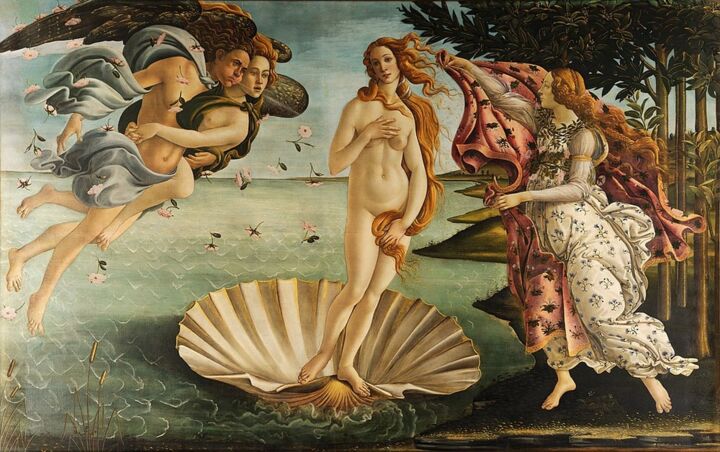 Sandro Botticelli, The Birth of Venus, 1485 c. Tempera on linen canvas, 172.5 x 278.5 cm. Florence: Uffizi Gallery.
Sandro Botticelli, The Birth of Venus, 1485 c. Tempera on linen canvas, 172.5 x 278.5 cm. Florence: Uffizi Gallery.
The Venus of Botticelli
Inside the Uffizi Gallery is preserved one of the most important masterpieces in the history of art: The Birth of Venus by Sandro Botticelli, dated 1485. This work, while re-proposing the Renaissance canon of beauty, also connects to the classical world, as it depicts a demure Venus, who is intent on covering her nudity with her long hair. In addition, even the personification of the winds, Zephyrus and, perhaps, Aura, who are depicted to the left of the goddess, represent an ancient quotation, recalling a gem of the Hellenistic age owned by Lorenzo the Magnificent. With regard to the topical subject addressed by the painting, the latter recounts the birth of Venus, who is immortalized, above a shell, as she rises from the waters. To the right of the goddess is Ora, who is intent on giving Venus a skilfully embroidered dress with rhythmic, flowing, light and elegant drapery. This same flowing, elegant rhythm has also been imposed on Venus' hair, which moves in the air. Overall, the painting seems to portray a theatrical scene, where the mythological characters, defined by a delicate linear outline, have pale, ebony complexions and slender, elongated physiques. Like the bodies of the actors on stage, the landscape, almost hinted at, has been realized in an almost two-dimensional way and lacks a definite chiaroscuro. As a result, in the work, marked by a light that illuminates the scene in a diffuse way, the space is contracted in the foreground.
 Vilgeniy Melnikov, Venus, 2020. Metal, aluminum and bronze, 80 x 30 x 27 cm.
Vilgeniy Melnikov, Venus, 2020. Metal, aluminum and bronze, 80 x 30 x 27 cm.
The Venus of Vilgeniy Melnikov
The impact that these three Venuses just described have had, both in the history of art and in the conception of female beauty, has been immense, so much so that they are still the object of attention by artists, including those of Artmajeur. Example of what has been said is the work of Vilgeniy Melnikov, entitled Venus, which reproduces, in a fairly faithful way, the features of the Venus of Willendorf. The work of Melnikov however, having been realized in the modern context, has been stripped of all those meanings that had been attributed to the Venus of the paleolithic. Moreover, unlike the Venus of Willendorf, Melnikov's work does not wear a headdress and, being made of metal, presents a smooth surface devoid of porosity. Despite this, even in this case the light, which is partially reflected on the surface of the work, gives those dark lights that help to define the generous forms of the statue. Finally, the black of Malnikov's Venus, in contrast to the yellowish color of the original, gives the work a greater elegance and more sinuosity to the goddess's procrustean forms.
 Secam, V.nus - Antik Gaming, 2019. Acrylic, stencil, and spray paint on linen canvas, 116 x 73 cm.
Secam, V.nus - Antik Gaming, 2019. Acrylic, stencil, and spray paint on linen canvas, 116 x 73 cm.
The Venus of Secam
In Secam's painting, the Venus de Milo becomes, like Andy Warhol's Marilyn Monroe, a pop icon, that holds in her hands, now lost in the Louvre masterpiece, an everyday object of mass consumer society: a television set. In addition, the Venus of Artmajeur's artist, depicted in a simple and two-dimensional way, stands out against a uniform background, which is intended to enhance the contours of the goddess, allowing an immediate reading of the work. In conclusion, in Secam's innovative painting, the values of Greek Hellenism, through which classical themes were addressed with greater sensuality, emotionality and pathos or drama, are replaced by those of popular art, which has wanted to transform a masterpiece of art history into a media character.
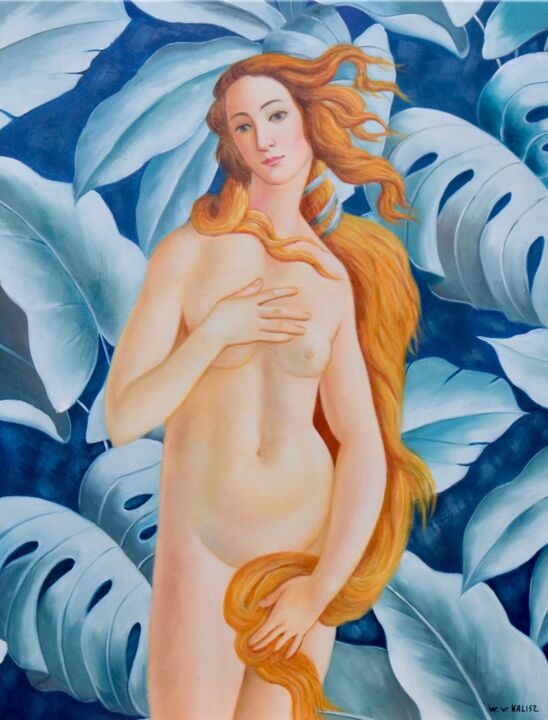 Wilhem Von Kalisz, Venus Forever, 2021. Oil on canvas \ mounted on stretcher frame, 92x71 cm.
Wilhem Von Kalisz, Venus Forever, 2021. Oil on canvas \ mounted on stretcher frame, 92x71 cm.
Venus by Wilhem Von Kalisz
The work of Von Kalisz, artist of Artmajeur, represents a new and highly original interpretation of Botticelli's Birth of Venus, in which the only character to have been depicted is the goddess, who stands out against an innovative blue background covered with large green leaves. Consequently, with the reduction in the number of characters and the loss of the original background, the work no longer tells the story of the birth of Venus, but becomes a true celebration of her beauty, that of Simonetta Vespucci. Simonetta Vespucci was one of the most famous noblewomen of the Florentine Renaissance, as she was considered to be of unparalleled beauty and became the desire of many men in Florence in the mid-fifteenth century. Moreover, Vespucci's name has often been linked to that of many artists of the time, for whom she would have posed. In the case of Botticelli, many wanted to recognize the face of Simonetta, as well as in Venus, also in that of the personification of Spring, so much so that it was even wanted to attribute to the two an emotional bond, which still remains legendary.

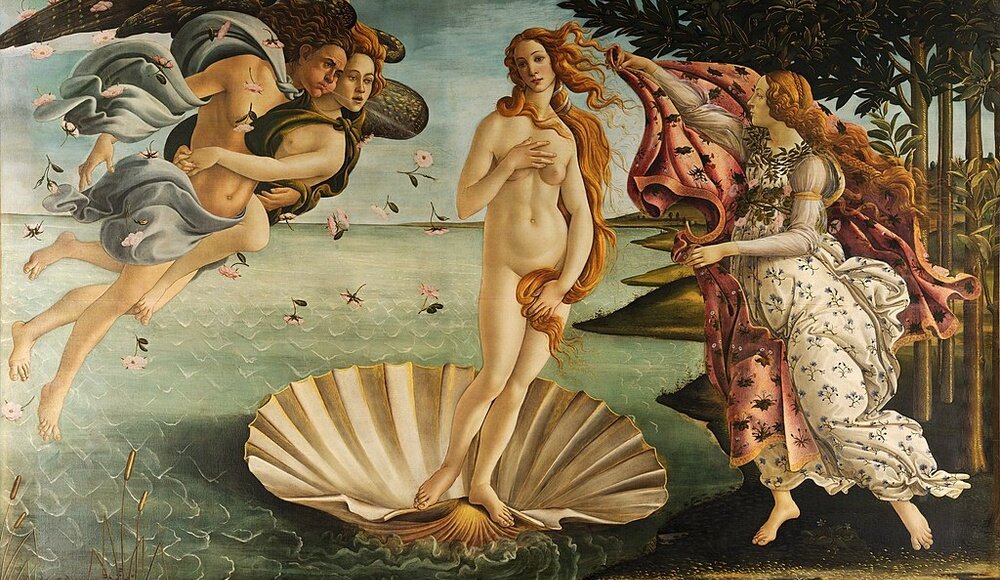
 Olimpia Gaia Martinelli
Olimpia Gaia Martinelli


